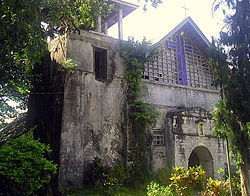Sagay, Camiguin
| Sagay | |
|---|---|
| Municipality | |

Sagay Church
|
|
 Map of Camiguin with Sagay highlighted |
|
| Location within the Philippines | |
| Coordinates: 9°07′N 124°43′E / 9.12°N 124.72°ECoordinates: 9°07′N 124°43′E / 9.12°N 124.72°E | |
| Country | Philippines |
| Region | Northern Mindanao (Region X) |
| Province | Camiguin |
| District | Lone district |
| Founded | July 31, 1909 |
| Barangays | 9 |
| Government | |
| • Mayor | Eugenio G. Ong |
| Area | |
| • Total | 44.13 km2 (17.04 sq mi) |
| Population (2015 census) | |
| • Total | 12,626 |
| • Density | 290/km2 (740/sq mi) |
| Time zone | PST (UTC+8) |
| ZIP code | 9103 |
| Dialing code | +63 (0)88 |
| Income class | 5th municipal income class |
| 101805000 | |
| Electorate | 8,376 voters as of 2016 |
| Website | www |
Sagay is a fifth class municipality in the province of Camiguin, Philippines. According to the 2015 census, it has a population of 12,626 people.
The town square of Sagay includes a British cannon. This cannon has been dated at 1707, and is a nine-pounder Demi-Culverin. It can clearly be identified as British by the emblem on the top which includes the Tudor rose. It was possibly left behind in 1763 after the siege of Manila, and perhaps was brought to Camiguin by the Spanish to defend against Moro raiders.
In 1909, the municipality of Sagay was created. Prior to this date, Sagay town had been a part of the municipality of Catarman. Initially, Sagay municipality included the town of Guinsiliban, but that later became a municipality in its own right.
In 1942, the Japanese Occupation forces entered the town of Sagay, Camiguin.
In 1945, the town of Sagay was liberated by the invasion of the Filipino forces of the 6th and 10th Infantry Division of the Philippine Commonwealth Army who attacked the Japanese Imperial forces during the Battle of Camiguin at the end of World War II.
Sagay is politically subdivided into 9 barangays.
In the 2015 census, the population of Sagay, Camiguin, was 12,626 people, with a density of 290 inhabitants per square kilometre or 750 inhabitants per square mile.
...
Wikipedia

